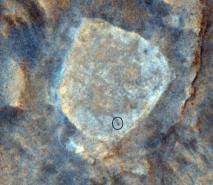The Mars rover "Spirit" is indicated by a circle on "Home Plate" in this new image of Gusev Crater on Mars. This detail is part of a much larger image the HiRISE camera took on Sept. 27, 2007. The rover has since driven north. (Photo: NASA/JPL/University of Arizona)
The High Resolution Imaging Science Experiment, or HiRISE, camera onboard NASA's Mars Reconnaissance Orbiter has taken a new color image of the feature dubbed "Home Plate" in Gusev Crater on Mars.
The Mars Exploration Rover "Spirit" shows up inside the perimeter of Home Plate, where it was when HiRISE took the image on Sept. 27, 2007, at 2:19 p.m. local Mars time, HiRISE team member Ken Herkenhoff of the U.S. Geological Survey, Flagstaff, said.
Spirit is driving toward the safe, north-facing slopes on the north side of Home Plate, which is toward the top of the image. There it will be positioned to tilt its solar panels toward the sun for the long Martian winter. Home Plate is a flat, raised feature that is probably a remnant of a deposit emplaced by an ancient eruption, Herkenhoff added.
The new color image of Home Plate was created using the camera's blue-green and red channels, Herkenhoff said. At the time, the camera was flying about 270 kilometers, or about 168 miles, over the surface. At that distance, the camera could resolve objects about 81 centimeters, or about 32 inches, across. The sun was about 56 degrees above the horizon in the winter afternoon sky.
The HiRISE image of Home Plate and others are on the HiRISE Website, hirise.lpl.arizona.edu . HiRISE operations are based at The University of Arizona in Tucson. Professor Alfred S. McEwen of the Lunar and Planetary Laboratory is principal investigator for the experiment.
The HiRISE camera is the most powerful camera ever to orbit another planet. It has taken thousands of black-and-white images, and hundreds of color images, since it began science operations in 2006.
A single HiRISE image will often be a multigigabyte image that measures 20,000 pixels by 50,000 pixels, which includes a 4,000-by-50,000 pixel region in three colors. It can take a computer up to three hours to process such an image.
Source: University of Arizona
























